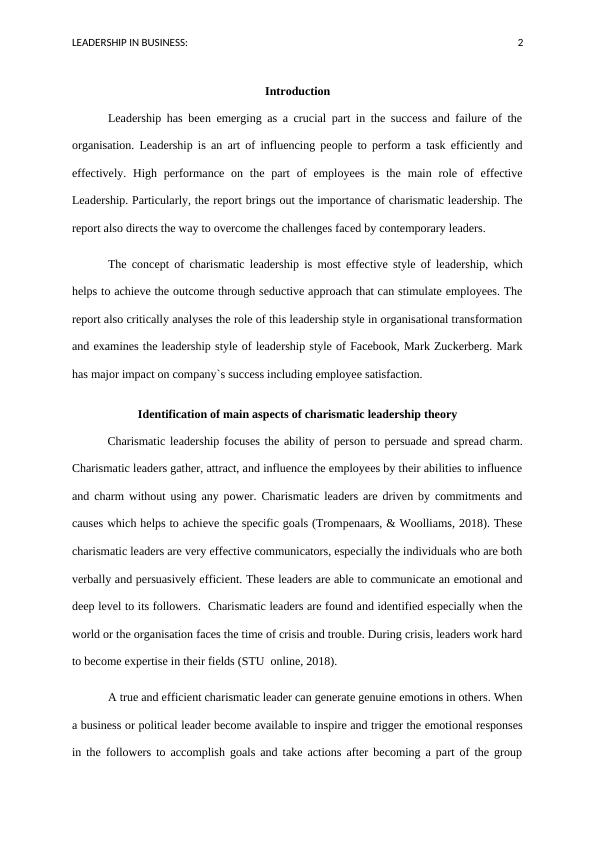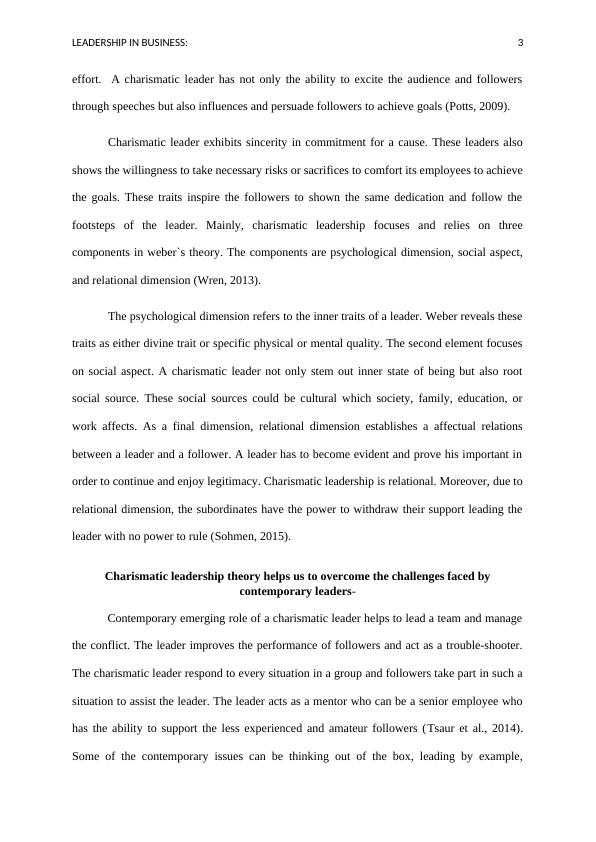Charismatic Leadership in Business: Challenges and Examples
Added on 2023-06-07
11 Pages2350 Words428 Views
leadership in business

LEADERSHIP IN BUSINESS: 1
Contents
Introduction...........................................................................................................................................2
Identification of main aspects of charismatic leadership theory............................................................2
Charismatic leadership theory helps us to overcome the challenges faced by contemporary leaders-...3
Demonstration of an example of a charismatic leadership.....................................................................4
Conclusion.............................................................................................................................................6
References.............................................................................................................................................8
Contents
Introduction...........................................................................................................................................2
Identification of main aspects of charismatic leadership theory............................................................2
Charismatic leadership theory helps us to overcome the challenges faced by contemporary leaders-...3
Demonstration of an example of a charismatic leadership.....................................................................4
Conclusion.............................................................................................................................................6
References.............................................................................................................................................8

LEADERSHIP IN BUSINESS: 2
Introduction
Leadership has been emerging as a crucial part in the success and failure of the
organisation. Leadership is an art of influencing people to perform a task efficiently and
effectively. High performance on the part of employees is the main role of effective
Leadership. Particularly, the report brings out the importance of charismatic leadership. The
report also directs the way to overcome the challenges faced by contemporary leaders.
The concept of charismatic leadership is most effective style of leadership, which
helps to achieve the outcome through seductive approach that can stimulate employees. The
report also critically analyses the role of this leadership style in organisational transformation
and examines the leadership style of leadership style of Facebook, Mark Zuckerberg. Mark
has major impact on company`s success including employee satisfaction.
Identification of main aspects of charismatic leadership theory
Charismatic leadership focuses the ability of person to persuade and spread charm.
Charismatic leaders gather, attract, and influence the employees by their abilities to influence
and charm without using any power. Charismatic leaders are driven by commitments and
causes which helps to achieve the specific goals (Trompenaars, & Woolliams, 2018). These
charismatic leaders are very effective communicators, especially the individuals who are both
verbally and persuasively efficient. These leaders are able to communicate an emotional and
deep level to its followers. Charismatic leaders are found and identified especially when the
world or the organisation faces the time of crisis and trouble. During crisis, leaders work hard
to become expertise in their fields (STU online, 2018).
A true and efficient charismatic leader can generate genuine emotions in others. When
a business or political leader become available to inspire and trigger the emotional responses
in the followers to accomplish goals and take actions after becoming a part of the group
Introduction
Leadership has been emerging as a crucial part in the success and failure of the
organisation. Leadership is an art of influencing people to perform a task efficiently and
effectively. High performance on the part of employees is the main role of effective
Leadership. Particularly, the report brings out the importance of charismatic leadership. The
report also directs the way to overcome the challenges faced by contemporary leaders.
The concept of charismatic leadership is most effective style of leadership, which
helps to achieve the outcome through seductive approach that can stimulate employees. The
report also critically analyses the role of this leadership style in organisational transformation
and examines the leadership style of leadership style of Facebook, Mark Zuckerberg. Mark
has major impact on company`s success including employee satisfaction.
Identification of main aspects of charismatic leadership theory
Charismatic leadership focuses the ability of person to persuade and spread charm.
Charismatic leaders gather, attract, and influence the employees by their abilities to influence
and charm without using any power. Charismatic leaders are driven by commitments and
causes which helps to achieve the specific goals (Trompenaars, & Woolliams, 2018). These
charismatic leaders are very effective communicators, especially the individuals who are both
verbally and persuasively efficient. These leaders are able to communicate an emotional and
deep level to its followers. Charismatic leaders are found and identified especially when the
world or the organisation faces the time of crisis and trouble. During crisis, leaders work hard
to become expertise in their fields (STU online, 2018).
A true and efficient charismatic leader can generate genuine emotions in others. When
a business or political leader become available to inspire and trigger the emotional responses
in the followers to accomplish goals and take actions after becoming a part of the group

LEADERSHIP IN BUSINESS: 3
effort. A charismatic leader has not only the ability to excite the audience and followers
through speeches but also influences and persuade followers to achieve goals (Potts, 2009).
Charismatic leader exhibits sincerity in commitment for a cause. These leaders also
shows the willingness to take necessary risks or sacrifices to comfort its employees to achieve
the goals. These traits inspire the followers to shown the same dedication and follow the
footsteps of the leader. Mainly, charismatic leadership focuses and relies on three
components in weber`s theory. The components are psychological dimension, social aspect,
and relational dimension (Wren, 2013).
The psychological dimension refers to the inner traits of a leader. Weber reveals these
traits as either divine trait or specific physical or mental quality. The second element focuses
on social aspect. A charismatic leader not only stem out inner state of being but also root
social source. These social sources could be cultural which society, family, education, or
work affects. As a final dimension, relational dimension establishes a affectual relations
between a leader and a follower. A leader has to become evident and prove his important in
order to continue and enjoy legitimacy. Charismatic leadership is relational. Moreover, due to
relational dimension, the subordinates have the power to withdraw their support leading the
leader with no power to rule (Sohmen, 2015).
Charismatic leadership theory helps us to overcome the challenges faced by
contemporary leaders-
Contemporary emerging role of a charismatic leader helps to lead a team and manage
the conflict. The leader improves the performance of followers and act as a trouble-shooter.
The charismatic leader respond to every situation in a group and followers take part in such a
situation to assist the leader. The leader acts as a mentor who can be a senior employee who
has the ability to support the less experienced and amateur followers (Tsaur et al., 2014).
Some of the contemporary issues can be thinking out of the box, leading by example,
effort. A charismatic leader has not only the ability to excite the audience and followers
through speeches but also influences and persuade followers to achieve goals (Potts, 2009).
Charismatic leader exhibits sincerity in commitment for a cause. These leaders also
shows the willingness to take necessary risks or sacrifices to comfort its employees to achieve
the goals. These traits inspire the followers to shown the same dedication and follow the
footsteps of the leader. Mainly, charismatic leadership focuses and relies on three
components in weber`s theory. The components are psychological dimension, social aspect,
and relational dimension (Wren, 2013).
The psychological dimension refers to the inner traits of a leader. Weber reveals these
traits as either divine trait or specific physical or mental quality. The second element focuses
on social aspect. A charismatic leader not only stem out inner state of being but also root
social source. These social sources could be cultural which society, family, education, or
work affects. As a final dimension, relational dimension establishes a affectual relations
between a leader and a follower. A leader has to become evident and prove his important in
order to continue and enjoy legitimacy. Charismatic leadership is relational. Moreover, due to
relational dimension, the subordinates have the power to withdraw their support leading the
leader with no power to rule (Sohmen, 2015).
Charismatic leadership theory helps us to overcome the challenges faced by
contemporary leaders-
Contemporary emerging role of a charismatic leader helps to lead a team and manage
the conflict. The leader improves the performance of followers and act as a trouble-shooter.
The charismatic leader respond to every situation in a group and followers take part in such a
situation to assist the leader. The leader acts as a mentor who can be a senior employee who
has the ability to support the less experienced and amateur followers (Tsaur et al., 2014).
Some of the contemporary issues can be thinking out of the box, leading by example,

End of preview
Want to access all the pages? Upload your documents or become a member.
Related Documents
Charismatic and Contingency Leadership Theories in Managementlg...
|4
|912
|23
Leadership in Organizations: Essaylg...
|10
|2549
|67
Important Theories of Leadership -lg...
|6
|1393
|25
The Importance of Charisma in Effective Leadershiplg...
|6
|945
|81
Charismatic Leadership and its Impact on Overcoming Challenges in the Global Business Environmentlg...
|7
|1660
|500
Assignment on Self Auditslg...
|10
|3351
|74
